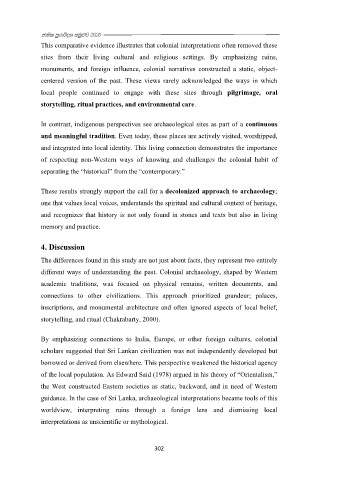Page 323 - Proceedings book
P. 323
q
cd;sl mqrdúoHd iu¿j 2025
This comparative evidence illustrates that colonial interpretations often removed these
sites from their living cultural and religious settings. By emphasizing ruins,
monuments, and foreign influence, colonial narratives constructed a static, object-
centered version of the past. These views rarely acknowledged the ways in which
local people continued to engage with these sites through pilgrimage, oral
storytelling, ritual practices, and environmental care.
In contrast, indigenous perspectives see archaeological sites as part of a continuous
and meaningful tradition. Even today, these places are actively visited, worshipped,
and integrated into local identity. This living connection demonstrates the importance
of respecting non-Western ways of knowing and challenges the colonial habit of
separating the “historical” from the “contemporary.”
These results strongly support the call for a decolonized approach to archaeology;
one that values local voices, understands the spiritual and cultural context of heritage,
and recognizes that history is not only found in stones and texts but also in living
memory and practice.
4. Discussion
The differences found in this study are not just about facts, they represent two entirely
different ways of understanding the past. Colonial archaeology, shaped by Western
academic traditions, was focused on physical remains, written documents, and
connections to other civilizations. This approach prioritized grandeur; palaces,
inscriptions, and monumental architecture and often ignored aspects of local belief,
storytelling, and ritual (Chakrabarty, 2000).
By emphasizing connections to India, Europe, or other foreign cultures, colonial
scholars suggested that Sri Lankan civilization was not independently developed but
borrowed or derived from elsewhere. This perspective weakened the historical agency
of the local population. As Edward Said (1978) argued in his theory of “Orientalism,”
the West constructed Eastern societies as static, backward, and in need of Western
guidance. In the case of Sri Lanka, archaeological interpretations became tools of this
worldview, interpreting ruins through a foreign lens and dismissing local
interpretations as unscientific or mythological.
302

